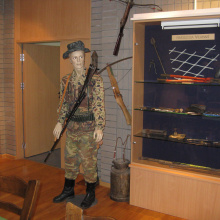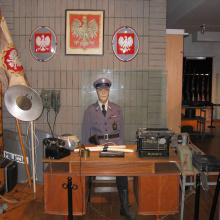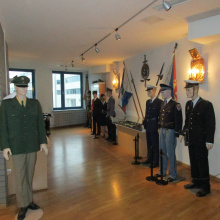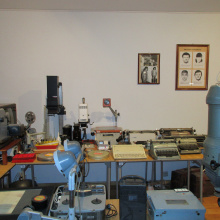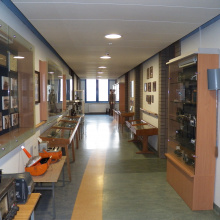The photo comes from the website of the Forensic Science Museum of the WPiA.
The Forensic Science Museum of the Faculty of Law and Administration of the University of Gdańsk houses a wide collection of exhibits from all fields of forensic science: ballistics, dactyloscopy, trace evidence, photography and others, as well as forensic medicine and related fields. In this respect, it is the only facility of its kind in Poland. The Museum of the Faculty of Law and Administration has been featured in an article about unobvious places in the 'City of Neptune', bringing together less popular but noteworthy locations in Gdańsk.
The Forensic Science Museum of the Faculty of Law and Administration UG has been collecting and disseminating forensic science and forensic medicine collections for over 30 years. This place is inextricably linked with the person of dr Jerzy Wnorowski, founder and long-standing head of the Forensic Science Laboratory of the Faculty of Law and Administration UG.
- 'Since 1983, the headquarters of the Laboratory has been the Prison Tower and Executioner's Facility complex in Gdańsk, and it was there that dr Wnorowski began to create the first museum exhibition. This was due to his unusual passion and interest in broadly defined criminalistics. All items which later became museum exhibits were originally owned by dr Wnorowski,' - says Janusz Czeczko, an employee of the Museum of Forensic Science, University of Gdańsk.
With time, when the collections started to grow, a museum of criminalistics was established in one of the rooms of the Prison Tower. As Janusz Czeczko points out, this was a perfect combination of history and the present - apart from the normal scientific and didactic activities, tours were organised around the facility, enabling visitors to learn not only about the history of the relic, but also about the history of the city's prisons, the history of the Inquisition process, and only then about the exhibits and the history of modern forensic science.
This activity continued until 2001 when the Forensic Science Laboratory moved to the new PiA Department building. At that time, the museum was still an integral part of the Forensic Science Laboratory. In 2012 it was decided to separate the museum from the Laboratory and create a separate unit. In 2013, the museum was opened as a new organisational unit of the Faculty of Law and Administration.
In the museum, there is a section of weapons and ammunition, where firearms, antique weapons, sporting weapons, gas weapons, alarms, signal weapons, pneumatic weapons, items designed to incapacitate people using electricity, self-propelled weapons, military weapons and equipment, uniforms are collected.
One can also see exhibits connected with forensic medicine, forensic documentation of famous cases, collections in the field of forensic photography, items used to commit criminal acts and originating from crimes, e.g. burglary tools, instruments and forensic equipment used to reveal and secure traces at crime scenes and speed measuring devices, counterfeit Polish and foreign banknotes and coins, and even items seized from inmates of penal institutions and remand centres.
The Museum collections, due to their function, historical and material value, are unique in the country.
- 'Their uniqueness consists primarily in the fact that they are often unique, one exhibit cannot simply be replaced by another, they relate to one specific case, e.g. nowhere else can one find casts of footprints of the Scorpion, one of the most famous criminals connected with Gdańsk, there is only one beam from the gallows in the Gdańsk detention centre,' - explains Janusz Czeczko.
Until recently the Museum of Forensic Science was open to people from outside. Currently, due to reasons connected with the pandemic, the unit is closed.
For up-to-date information, visit the website of the Museum of Forensic Science.
As part of the Cultural Scholarship of the City of Gdańsk, awarded to persons involved in artistic creation and popularisation of culture, an article has been written by Kamil Gabryszak about unobvious places in the 'City of Neptune'. The publication includes over 50 less popular, noteworthy locations, among them the Museum of Forensic Science of the Faculty of Law and Administration of the University of Gdańsk.
- 'The guide creates an excellent alternative to the most besieged routes in Gdansk. The text encourages both residents of the capital of Pomorskie Voivodeship and tourists to go off the main routes of "the city of Neptune",' - says Kamil Gabrysiak, the author of the guide. - 'Currently, the text has been qualified for the prize of the month in the competition of the largest travel website fly4free.pl, in addition, the publication was made available by the travel service lata.my.pl, the publishing house M. Kosycarz publishing house and the Old Toys Gallery.'.

